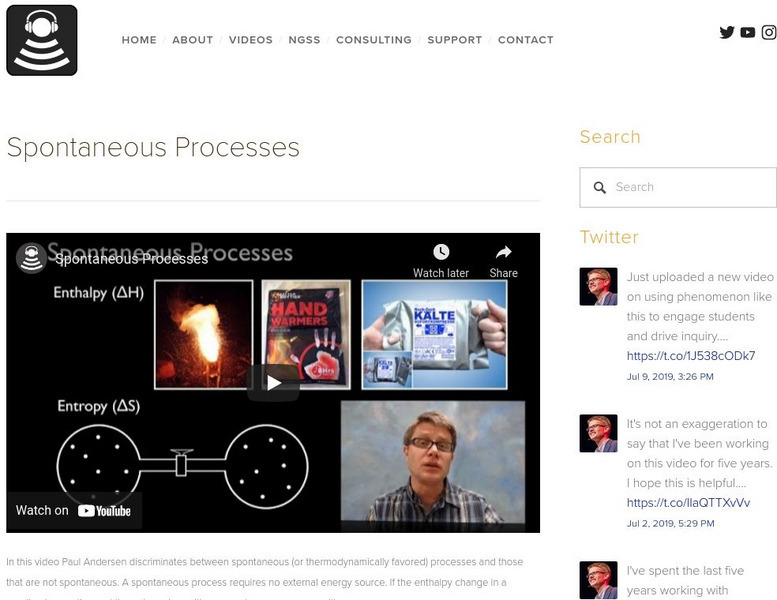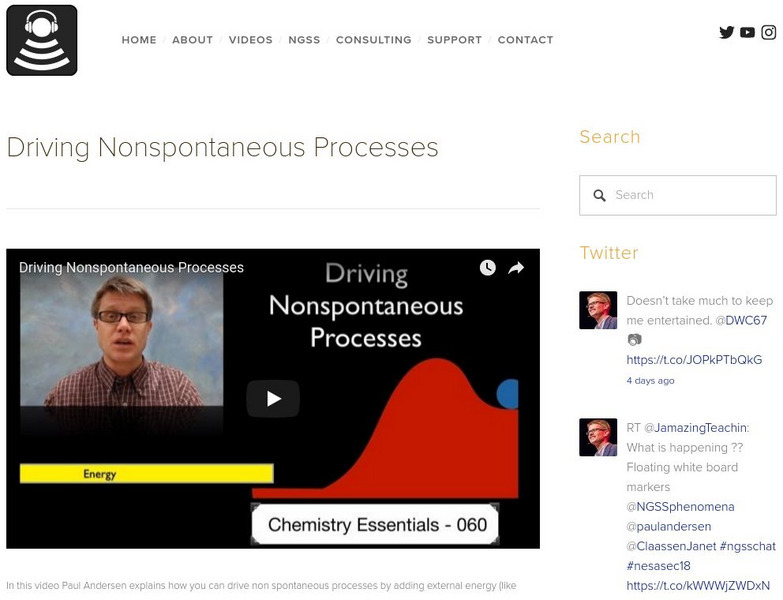Mazz Media
Introduction to Thermochemistry
This video begins with real world examples of heat transfer involving energy changes from chemical potential energy. The program shows exothermic reactions which occur such as a gasoline engine, wood on a campfire and athletes running....
Sophia Learning
Sophia: Energy Diagram of a Chemical Reaction
This lesson will introduce the energy diagram of a chemical reaction, and label the parts of the diagram.
Bozeman Science
Bozeman Science: Spontaneous Processes
In this video, Paul Andersen discriminates between spontaneous (or thermodynamically favored) processes and those that are not spontaneous. A spontaneous process requires no external energy source. If the enthalpy change in a reaction is...
Bozeman Science
Bozeman Science: Driving Nonspontaneous Processes
In this video, Paul Andersen explains how you can drive nonspontaneous processes by adding external energy (like electricity or light) or by coupling it to a spontaneous process (like the conversion of ATP to ADP). Utilize the concept...
Khan Academy
Khan Academy: Chemistry: Macrostates and Microstates
A video lecture exploring the difference between macrostates, microstates, and thermodynamic equilibrium. Understand how macrostates is best defined when the system is in thermal equilibrium and describes pressure, temperature, and...
Khan Academy
Khan Academy: Chemistry: More on Internal Energy
A video lecture that explores internal energy and how to calculate how much heat is transferred to or from the system. Lecture gives examples to help your understanding of the concepts. [13:45]
Khan Academy
Khan Academy: Chemistry: Work Done by Isothermic Process
A video lecture explaining how to find the work done in an isothermic process. Lecture defines how the adiabatic process is isolated from world and an isothermic process keeps the temperature the same. Video looks at temperature, ideal...
Khan Academy
Khan Academy: Chemistry: Chilling Water Problem
Figure out how many grams of ice is needed to lower the temperature of water by sixty degrees in this video lecture. The lecture explains how the ice absorbs heat from the water to lower the temperature. Using the specific heat of water...
Khan Academy
Khan Academy: Chemistry: Proof: U=(3/2)pv or U=(3/2)n Rt
A video lecture that relates pressure, volume, and temperature to internal energy. The lecture shows how to derive an equation for the ideal gas to relate internal energy and pressure and volume. The video shows that if the temperautre...
Khan Academy
Khan Academy: Bond Enthalpy and Enthalpy of Reaction
Introduction to bond enthalpy, and how to use bond enthalpies to calculate enthalpy of reaction. [11:46]
Khan Academy
Khan Academy: 2015 Ap Chemistry Free Response 7
In this free response questions, students were asked to calculate the energy necessary to recycle aluminum from aluminum oxide. The video will explore step-by-step how to solve the free response problem from an AP Chemistry exam. [6:15]
Khan Academy
Khan Academy: 2015 Ap Chemistry Free Response 2 C
Do you need to review Gibbs free energy and equilibrium constant of dehydration reaction for the AP Chemistry exam? This video works a free response question from the AP Chemistry exam. [12:22]
Khan Academy
Khan Academy: Changes in Free Energy and the Reaction Quotient
This video lesson from Khan Academy is intended for students who are taking the AP Chemistry course. The relationship between Gibbs free energy, standard Gibbs free energy, and the reaction quotient Q. Predicting the direction of the...
Sophia Learning
Sophia: Define Energy: Kinetic and Potential
This lesson will define kinetic and potential energy, particularly as it relates to chemical reactions.














